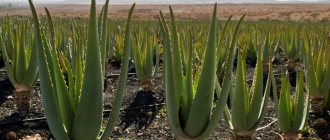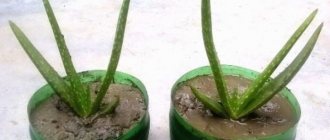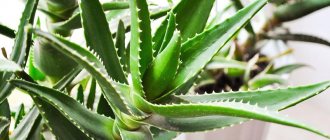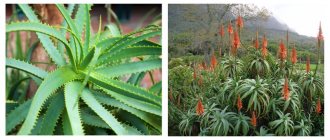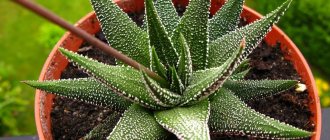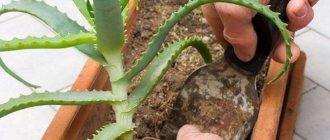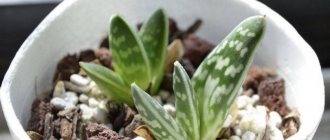After all, agave is bred not for beauty, but for home treatment and skin care (women will understand). But if you already have such a green pet, there is no need to purchase new ones. Even a child can cope with aloe propagation!
I’ll tell you in the article how this is done and what methods exist for this.
Home doctor - aloe
Mentions of this culture are found in the works of famous healers - Paracelsus, Hippocrates, Avicenna. Cleopatra also recognized the healing power of the humble flower.
In the natural environment, aloe grows in Africa and the Arabian Peninsula. This representative of the Asphodelaceae family includes more than 550 species, of which aloe vera, arborescent, variegated, spinous and fan have gained wide popularity as indoor plants.
A hot climate and dry air are familiar to tropical trees. In addition, it is well adapted to dry, poor soils of a clay or sandy nature. Therefore, at home, the agave lives happily ever after.
“In the wild,” the succulent captures new areas with the help of self-seeding and root layering (children). Indoor specimens are also propagated by leaves, cuttings and tops. The convenience of one method or another depends on the availability of time, the required number of plants and the type of aloe.
The plant can be propagated all year round, but the optimal time is the end of spring and the first two summer months.
How to prepare a flower?
Preliminary preparation significantly increases the chances of a successful transplant. They work with the flower according to the following scheme:
- Water thoroughly 3-4 hours before transplanting.
- Turn the pot over and tap it with your palm on all sides. If the roots have grown too much and the flower does not want to fall out of the pot, the flowerpot will have to be broken. If you forcibly cut aloe from a planting container using a spatula, the root system will suffer irreversible damage and, most likely, the plant will die.
- Separate old adhering drainage from the bottom of the earthen clod.
- Inspect the remaining rhizome. If you find rotten or moldy roots, shake off as much soil as possible, carefully disassemble it with your hands and rinse with running water.
- Trim diseased or damaged roots with scissors. Sprinkle the cuts with charcoal.
Soil selection
The substrate for aloe should be as close as possible to the soil in its growing area. Criteria that the soil must meet:
- Breathability. The soil should be so crumbly that even after watering it is difficult to form a ball.
- Low acidity. The maximum permissible pH level is 8.0. It is desirable that the substrate be neutral.
- High iron content. This element stabilizes photosynthesis processes in succulents.
This is interesting: Roicissus plant: home care for indoor birch
You can buy soil in the store (for succulents and cacti) or prepare it yourself. To do this, turf and sand are combined in a 1:2 ratio, nutrients and vermicompost are added.
Important! The earth is pre-steamed in the oven at a temperature of +60 °C. This destroys the germs and insects in it.
Soil requirements
In natural wild conditions, aloe lives in hot and arid climates, inhabiting infertile, poor, dry clay or sandy places. Therefore, in home and apartment conditions, after propagation, the flower will feel comfortable in an environment as close to natural as possible. The composition of the soil must be selected correctly, since the full development of the plant directly depends on this.
The soil mixture for aloe, which is considered a succulent, must be loose and free-flowing, not retain moisture and allow air to pass through without problems, and also contain the required amount of ferrous substances. The desired acidity level is close to neutral (6.7-7 pH). Such soil mixtures, intended for succulent and cactus crops, can be purchased at any florist or gardening store. However, many gardeners prefer to mix the substrate when propagating aloe themselves, preparing the following components (2:1:1):
- fertile soil (garden, leaf, turf, etc.);
- sand (only coarse, necessarily sifted and washed from dust) or fine gravel;
- humus or garden compost.
Before proceeding directly to propagation, it is recommended to disinfect the soil mixture prepared for aloe:
- spilling potassium permanganate dissolved in water;
- calcined in the oven;
- keeping it at maximum heating mode in a microwave oven;
- steamed in a water bath;
- frozen (can be in the freezer).
Preparing for aloe propagation
Vermiculite gives the soil looseness and improves its moisture capacity
To grow aloe at home you will need:
- A container with drainage holes, at least 10-15 centimeters in diameter and the same depth. If you plan to separate the children without roots, you should also stock up on a container of water for their germination.
- Soil mixture. The easiest way is to buy soil intended for succulents at a flower shop. But you can also prepare the mixture yourself (I’ll share the recipe a little later).
- Trowel.
- Sharp pruning shears or knife.
- Clean water for irrigation.
- Root formation stimulator - Zircon, Kornevin, Heteroauxin, Etamon, Ribav-Extra or any other analogue.
- Vodka or a strong solution of potassium permanganate to disinfect instruments.
This list is comprehensive—not all items on the list may be needed for a particular method. Therefore, it is important to carefully study the chosen technique in order to prepare only the essentials.
If the planting container is not new, it must be thoroughly disinfected. A ceramic vessel can be calcined in the oven for 10-15 minutes. Plastic containers are simply washed thoroughly with water and laundry soap and then rinsed. And clay pots can be soaked in a two percent solution of superphosphate or copper sulfate. By the way, clay products can also be treated with heat, but only place them in a cold oven, and only then turn on the heat.
The soil for aloe should be crumbly, moderately fertile, neutral or slightly acidic (with a pH of 5.5 to 7). To make such a mixture, take 2 parts of garden or turf soil, one part of sand and one part of compost or humus.
For each liter add 2-3 teaspoons of crushed gravel, 2-3 teaspoons of charcoal powder and 30-50 grams of wood ash. These additions are desirable, but not required.
Advice. To fluff up the soil, you can use perlite or vermiculite instead of gravel and coal.
How to propagate aloe: 5 proven methods
Leaf
To get a new aloe plant from a leaf, you need to do the following:
- Disinfect a knife or pruning shears with strong alcohol, a lighter or a raspberry solution of potassium permanganate.
- Select leaves that are at least 8 centimeters long, without spots, yellowing or signs of wilting. They are usually located in the lower tier of the plant. At the same time, it is recommended not to take more than 2-3 leaves from the plant at a time, so as not to excessively weaken the bush.
- The leaves are removed as close to the base as possible, the knife is held obliquely.
- Place the separated parts on gauze or a napkin and place in a dark closet for 1-3 days. This is necessary so that a thin transparent film forms on the cut. If she has not appeared during this time, wait another 1-2 days.
- Treat the leaves with an antiseptic: crushed charcoal or activated carbon, ash.
- Plant them with a depth of 3-4 centimeters in containers with a diameter of 10-15 centimeters.
- Place the container in a warm place with indirect sunlight. For example, during the rooting period, you can stick a newspaper on the window. The bowl with seedlings is watered every day, and the leaves are sprayed.
On a note. Some gardeners do not cover the leaves with soil, but simply place them on the ground. Usually they quickly send out roots and go to the desired depth.
After the leaves have taken root, they are planted in separate pots.
Cuttings
The cutting is a developed side shoot 8-10 centimeters long with at least 6 full leaves. To separate it from the mother plant, use disinfected scissors with a long blade or a stationery knife. At the same time, they are cut so as not to leave hemp.
The aloe sprig is placed in a place without access to light, with a humidity of at least 50%. After 5-7 days, when the wound is covered with a film, it is sprinkled with wood ash (crushed coal) and planted in a pot with a loose, moist substrate.
The recommended planting depth is 2-3 centimeters, but you need to ensure that the lower leaves do not come into contact with the ground. A distance of 8-10 centimeters is maintained between cuttings.
The bowl is exposed to diffused light in a room with a temperature of +20...25 degrees. The roots form after 2-4 weeks. Then small aloe plants are placed in separate pots (if they are no longer growing in individual containers).
Children
When they talk about propagating aloe by adventitious shoots, dormant buds, root shoots, and children, they mean planting tiny aloe plants that form at the base of the main stem. But they appear only in adult agave. Children grow especially abundantly if the plant is planted in a cramped flowerpot. This puts it in a situation of survival, so that it devotes all its energy not to its own development, but to the production of offspring.
Attention! Appendages greatly weaken an adult bush, so it is important to remove them in a timely manner.
Here's how to plant aloe babies step by step:
- 2-3 hours before starting work, the soil in the container is generously moistened.
- Aloe is carefully pulled out of the pot, trying not to tear off the roots.
- Remove excess soil and separate the shoots manually or with a knife so as to preserve the roots on them. Specimens that are too small and without roots are rejected.
- New plants are placed in separate pots with a moist, porous substrate. Planting depth is 1-1.5 centimeters.
- The mother tree is returned to the old container or transplanted into a larger one.
- Until the babies take root, they are kept warm and in partial shade.
It happens that aloe has produced a lot of shoots, but there is no desire or opportunity to bother with their separation. Then I do this. I just cut them from the bush with a sharp knife. Then I put it in water for a week or two (the water needs to be changed periodically). Usually 80-90% of the children produce good roots - I plant them in small pots in the usual way.
Or you can treat children without roots in the same way as with cuttings. That is, put them in a warm cupboard for 2-3 days to dry, etch the cut with charcoal and plant it in containers.
Top
To propagate aloe with the top, the top of an adult bush with 7-8 full leaves is separated. This injures the plant, but from such a shoot a large agave quickly grows.
On a note. The method is often used to rejuvenate aged succulents.
Here are complete instructions for rooting the apical part of aloe:
- A knife or pruning shears is sterilized in a solution of potassium permanganate or over an open fire.
- The top of the agave is cut off so that 6-8 leaves remain on it.
- The cut is immersed in water with the addition of Heteroauxin, Kornevin or any other root former for 30-40 minutes.
- You can keep the top in a warm and dark place until the wound is covered with film, as some gardeners do. But this item is optional.
- The shoot is soaked in water until roots appear. The water in the container is changed every 2-3 days, and it is also added as it evaporates.
- When the length of the roots is 5-6 centimeters, the shoot is planted in a separate pot. This usually takes 7-10 days.
Seeds
The option of seed propagation of aloe is not suitable for an amateur gardener. At home, aloe blooms reluctantly, and the plant’s seed material cannot be found in a regular store (although you can probably order it online).
The optimal time for this is the end of winter and the first half of March.
To complete the picture, let’s consider the main steps needed to reproduce aloe using this method:
- Seeds are placed in a solution of Zircon or Epin-Extra for 6-8 hours. You can take any other growth activator and process it according to the instructions.
- Flat, low containers are filled with a loose mixture (it is better to take special soil for succulents), not reaching the edge 2-3 centimeters.
- Grooves are made in them at a distance of 3-5 centimeters from one another and 2-3 centimeters deep.
- Wet seeds are placed in spilled grooves every 1.5-2 centimeters. This can be done easily with tweezers or the tip of a pencil.
- The soil mixture is watered again from a spoon with clean water.
- The container is covered with polyethylene or glass and placed in a warm (+20...25 degrees) and shaded place.
- Every day the shelter is opened slightly for ventilation, and the soil is irrigated with a spray bottle.
- The first loops will appear within 7-10 days, and complete germination can take up to three weeks.
After complete germination, the film is removed and the container is moved to a sunny window. When the plants produce 2-4 true leaves, they are planted in individual containers.
On a note. To get a large flower using this technology, it will take at least two years.
The process of transplanting aloe into a new pot
There are several ways to transplant aloe. All the methods are quite easy, so even a novice gardener can handle them by following the instructions.
Transplantation with roots
The most common way to replant a plant is to replant with roots.
Instructions:
- Carefully remove the plant from the old pot. You can turn the pot over slightly, or try pushing the old potting soil with a stick through the hole in the bottom of the pot.
- Free the plant's roots from old soil. If the soil is very dry, it is recommended to immerse the root system in warm water for a short time.
- If there are damaged roots, they must be removed. Be sure to treat the cut areas.
- Take a new pot, add drainage and some soil.
- Now you can plant the aloe in a new pot; the top layer of soil needs to be lightly compacted.
- After transplanting, aloe does not need to be watered for a week, and it is also not recommended to place it in highly lit places.
- In addition, you should not apply any fertilizing or fertilizer in the next six months after transplantation.
Transplanting aloe without roots
This method will be relevant if the plant is very stretched upward, the stem is completely bare, and the leaves remain only on the top of the head.
So, to replant, you need to carefully cut off the top of the plant with a sharp knife. The cut area must be treated
It is important to let the plant dry for several days, preferably in a dark place.
After these procedures, we place the plant in water or moistened sand so that roots appear. As soon as the roots appear, the plant can be planted in the soil.
Scion transplantation
This method of plant transplantation is also the most common propagation method for aloe.
With this method, the most important procedure will be the correct processing of the cut site on the mother plant and on the shoot.
After you have cut off the side shoot and treated all the cut points, the shoot should be sent to a dark place for several days, and then placed in water. When the roots appear, it’s time to plant the shoot in a separate pot.
Mistakes when propagating aloe
Aloe grows quickly and requires regular replanting
Sometimes children and cuttings do not produce roots and rot or dry out. This is due to inaccurate adherence to rooting rules.
Use of low quality soil mixture . A prerequisite that any soil for germinating aloe must meet is looseness.
Lack of disinfection of soil, containers, cuttings . Harmful bacteria provoke rotting, as a result of which roots either do not form or die.
Excess or lack of moisture in the soil . The overfilled soil is too dense and air does not penetrate into it. And without oxygen, plants cannot extract nutrients and dry out. If there is a lack of water, roots simply do not form.
How to care for aloe after rooting
Young aloe seedlings need moderate lighting. During spring-summer propagation, the plant is protected from aggressive sun by shading nets. Or you can simply place the containers at some distance from the window glass.
Starting next year, with the onset of steady warmth, they gradually begin to “walk” them on the balcony or in the garden. They start with 1-2 hours, and over time the aloe is moved to fresh air for the whole day, and then all night.
By the way. Some gardeners plant their pets in open ground for the summer.
The temperature in the room is maintained around +20 degrees in summer, and not lower than +14 degrees in winter. Regular ventilation is required, but you need to make sure there is no draft.
If you decide to start planting succulents in late autumn or winter, after rooting the babies are illuminated with phytolamps (at least 3 hours a day).
In the warm season, small aloe plants are watered 1-2 times a week, in winter - two to three times a month. The main thing is to wait for the upper level of the soil to dry out, because the crop does not tolerate waterlogging. Water is applied at the root so that drops do not fall into the axils of the leaves. The leaves are regularly wiped with a damp cloth to remove dirt and dust.
When planting in fertile soil, the first fertilizing is done no earlier than six months later. Special complex formulations for succulents are better suited for this. The optimal time is mid-spring, before active growth begins.
Advice. An adult flower is fertilized no more than once or twice a year. At the same time, it is convenient to water and fertilize through a tray to avoid overflow.
The first transfer to a larger vessel is carried out after a year, preferably in spring or summer. In the future, the operation is repeated annually until the plant reaches five years.
Pests of aloe are sometimes bothered by mealybugs and scale insects. For treatment, the plant is removed from the flowerpot, all soil is removed and treated with an insecticide, garlic tincture, vinegar solution or soap solution. Then it is transplanted into clean soil and a disinfected pot. And to find out what ails your family doctor, I suggest reading the article.
Tips and tricks
Flower growers often encounter problems in propagating aloe, which is explained by mistakes made. If this was the case, it is better to plant the shoots again if an adult plant is available.
The worst thing about growing aloe is considered to be an invasion of pests. Scale insects and mealybugs are isolated here. To get rid of uninvited guests, you need to transplant the plant into a new substrate, rinsing the pot with disinfectants.
The plant itself is treated with a solution - soap and garlic are mixed in equal quantities, the composition is added to warm water. Next, moisten the sponge in the solution and wipe the aloe leaves along with the cuttings. After treatment, the plant is planted in new soil.
Propagation of aloe is not difficult if everything is done according to the rules and in compliance with the recommendations presented. Small mistakes made may not show up in the future, since this plant is unpretentious in care.
Watch a video about aloe propagation:

